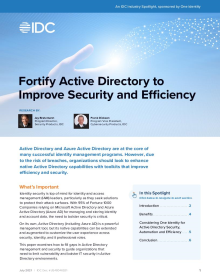Interest in Zero Trust and identity security technologies is surging for IT leaders worldwide as breaches and targeted threats increase for organizations worldwide. Many wonder if they are making the right investments in security solutions to enable Zero Trust security models in addition to addressing compliance, ensuring privacy and assessing risk.
To further understand how IT leaders currently approach cybersecurity strategy and investments, we sought the findings from recent IDC Research to dig into what technologies companies are investing in for security and Zero Trust. In their 2021 research survey, IDC asked over 450 IT leaders about which IT security offerings they are using or plan to use in the next 12 months. The data shows that identity is foundational to trust – as 79% of the IDC survey respondents report using or are planning to use identity and access management (IAM) tools to enable trust in their organizations.
Unified identity security as a core building block for Zero Trust
By now, most understand that Zero Trust is a proven model for implementing robust and selective security. It eliminates vulnerable permissions, unnecessary and excessive access in favor of specific rights delegation and provisioning with granularity. Shifting from a fragmented to a unified state for identity security allows organizations to take a giant leap forward in delivering on this promise.
Zero Trust success starts with casting the net wide enough. This means focusing not just on people but also on machine identities and ever-expanding accounts as organizations move to a multigenerational, hybrid and edge IT landscape. If you draw the circle too small, you stand to leave the side door open to bad actors. Unifying your identity security strategy helps ensure you avoid this issue.
A second key element of Zero Trust is delivering a continuum of rights across the organization. With added visibility and insights available, security professionals can more quickly and efficiently add, remove and adjust privilege just in time. In doing so, they can control user access to only what’s needed for his or her job, and only at the right moment – while eliminating error-prone manual processes and heavy IT involvement.
Finally, a key element of Zero Trust is adaptability, which is enabled with a unified identity security strategy. By leveraging a holistic approach that includes contextual awareness and behavior analytics, organizations can more quickly and efficiently anticipate, detect and take corrective actions that address emerging threats.
Our company, One Identity by Quest, partners with Microsoft for a combined approach to security – leveraging Microsoft Active Directory and Azure Active Directory combined with One Identity Active Roles. These combined solutions are better together and provide the security needed to enable Zero Trust and secure the people, data and applications across your organization.




